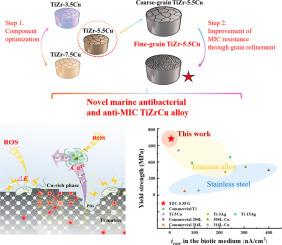A novel fine-grained TiZrCu alloy tailored for marine environment with high microbial corrosion-resistance
IF 14.3
1区 材料科学
Q1 MATERIALS SCIENCE, MULTIDISCIPLINARY
引用次数: 0
Abstract
Titanium alloys, usually known as non-corrodible material, are susceptible to microbiologically influenced corrosion (MIC) in marine environment. While titanium-zirconium (TiZr) alloys have been extensively studied in medical applications, the influence of microorganisms, especially marine microorganisms, on their corrosion behavior has not been explored. In this work, a TiZrCu alloy with a combination of excellent mechanical, anti-corrosion, and antibacterial properties was developed by optimizing the Cu content and grain refinement. Its MIC and antibacterial mechanisms against Pseudomonas aeruginosa, a representative marine microorganism, were systematically investigated. 5.5 wt% was determined as the optimal copper content. The fine-grained Ti-15Zr-5.5Cu (TZC-5.5FG) alloy maintained high MIC resistance, exhibiting a corrosion current of 5.7 ± 0.1 nA/cm2 and an antibacterial rate of 91.8 % against P. aeruginosa. The mechanism of improved corrosion resistance was attributed to the denser passive film with high TiO2 content and the lower surface potential difference ΔE. The release of Cu2+ ions, ΔE, and the generation of ROS are three major factors that contribute to the antibacterial performance of TiZrCu alloys. Compared to other available marine metals, TZC-5.5FG alloy exhibited superior comprehensive performance, including excellent mechanical properties and anti-MIC capacity, which make it a promising material for load-bearing applications in marine environment.

为海洋环境量身定制的新型细粒度 TiZrCu 合金具有很强的抗微生物腐蚀能力
钛合金通常被称为非腐蚀性材料,在海洋环境中容易受到微生物腐蚀(MIC)的影响。虽然钛锆(TiZr)合金在医疗应用中得到了广泛的研究,但微生物,尤其是海洋微生物对其腐蚀行为的影响尚未得到探讨。在这项研究中,通过优化铜含量和晶粒细化,开发出了一种兼具优异机械性能、抗腐蚀性能和抗菌性能的 TiZrCu 合金。研究人员系统地考察了该合金的 MIC 值以及对具有代表性的海洋微生物铜绿假单胞菌的抗菌机制。5.5 wt% 被确定为最佳铜含量。细粒度的 Ti-15Zr-5.5Cu (TZC-5.5FG) 合金保持了较高的耐 MIC 性能,对铜绿假单胞菌的腐蚀电流为 5.7 ± 0.1 nA/cm2,抗菌率为 91.8%。耐腐蚀性能提高的机理是由于 TiO2 含量高,被动膜更致密,表面电位差 ΔE 更低。Cu2+ 离子的释放、ΔE 和 ROS 的产生是促成 TiZrCu 合金抗菌性能的三个主要因素。与其他现有的海洋金属相比,TZC-5.5FG 合金表现出更优越的综合性能,包括出色的机械性能和抗 MIC 能力,使其成为海洋环境中一种有前途的承重材料。
本文章由计算机程序翻译,如有差异,请以英文原文为准。
求助全文
约1分钟内获得全文
求助全文
来源期刊

Journal of Materials Science & Technology
工程技术-材料科学:综合
CiteScore
20.00
自引率
11.00%
发文量
995
审稿时长
13 days
期刊介绍:
Journal of Materials Science & Technology strives to promote global collaboration in the field of materials science and technology. It primarily publishes original research papers, invited review articles, letters, research notes, and summaries of scientific achievements. The journal covers a wide range of materials science and technology topics, including metallic materials, inorganic nonmetallic materials, and composite materials.
 求助内容:
求助内容: 应助结果提醒方式:
应助结果提醒方式:


